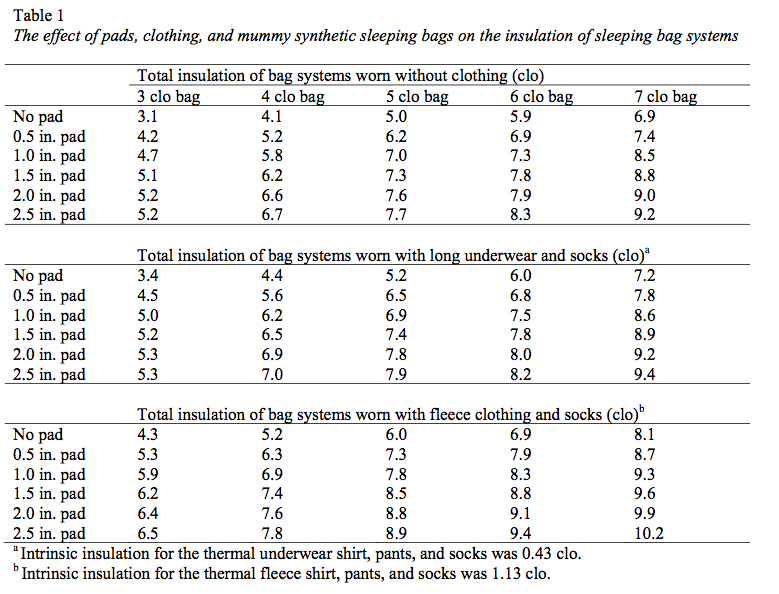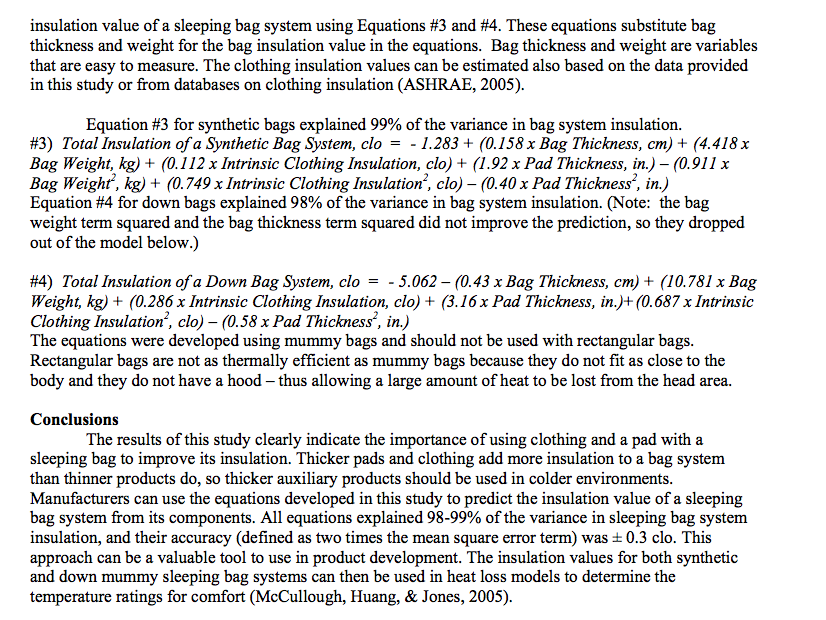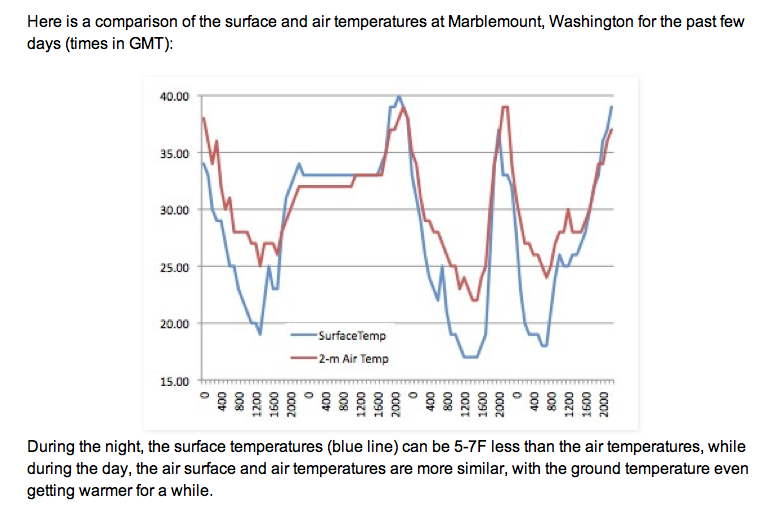Topic
EN Ratings and R Values; how do these align?
Forum Posting
A Membership is required to post in the forums. Login or become a member to post in the member forums!
Home › Forums › Gear Forums › Gear (General) › EN Ratings and R Values; how do these align?
- This topic has 28 replies, 8 voices, and was last updated 8 years ago by
 Michael Glavin / Zenbivy.
Michael Glavin / Zenbivy.
-
AuthorPosts
-
Feb 17, 2017 at 6:17 pm #3451144
Hey BPL:
I’m developing a new kind of sleeping bag (more on that in a couple of weeks), and am about to spend a bunch of money on lab testing. But before I do, I thought I would ask the community for some thoughts.
Has anyone ever tried to draw a correlation between EN (sleeping bag) ratings and R value (sleeping pad) ratings? The theory I am about to test is that most users buy a bag that is significantly warmer than the pad they use it on. Especially in today’s era of air mattresses that have R values between 1 and 3, I am thinking we generally pair our bag with a pad that is not warm enough.
I have done some anecdotal testing that leaves me to believe this is true, but have been unable to locate any actual data.
For instance, I think it is pretty common to pair a 30degree EN bag with a pad of R value of 3. But I THINK (don’t know) that the pad is the weak link there, and that an R value of 4-5 would better match the bag.
Anyone have any thoughts or experiences to share? Thanks as always!
Feb 17, 2017 at 6:43 pm #3451149There are just too many variables to simplify pad and bag combo’s IMO. Hundreds of pages have been written about the relationship between the two here on BPL. It sounds like you may be looking to blend the 2 in your new design. I would caution to go on the high side of R value if so. Your buyers (if there out there) will not complain about being too hot but they will not be happy campers if too cold.
I would think about passing for now on “expensive” lab testing and make a short run of product up and send them to as many real life users as possible. Especially self proclaimed cold sleepers. Again IMO you will learn a lot more. There is a reason WM does not have an EN rating. I would guess they really don’t care about all that. They field test and earned their customer base with actual results.
Feb 17, 2017 at 6:44 pm #3451150It’s complicated.
You could decrease sleeping bag R value by some amount and increase pad R value by some other amount and have the same amount of total heat lost.
The temperature of the ground can be different than air
The ground has some R value
The weight to get 1 R of pad is more than the weight to get 1 R of sleeping bag
etc.
Feb 17, 2017 at 8:21 pm #3451164“But I THINK (don’t know) that the pad is the weak link there, and that an R value of 4-5 would better match the bag.”
In an idealistic scenario, if a R-3 top is just enough to keep a person warm, anything more than that is wasted. And you would have to say the same thing if you were looking at the sides of a sleeping bag/quilt.
Why would the bottom be any different?
Perhaps because many of the real world pad numbers are just marketing – overlooking inflation/thickness issues, edge losses, moisture degradation, the marginal application of idealized materials, and testing that doesn’t reflect the infinite variations of sleeping styles.
Increasing the R-value of the matt by 40% would be safe, and in some cases worthwhile.
Identifying the physics and ergonomics affecting the “functional” R-value will be difficult.
Feb 18, 2017 at 2:11 am #3451190



;)
Feb 18, 2017 at 2:27 am #3451191as a note 0.5″ foam pad is roughly 1.3-1.5 R-value
as one can see with a simple plot … the effects beyond 1.5″ diminish quickly for synth … while for down it slows down but is still significant ..
synth provides more ground insulation than down (moot point in a quilt)
also for “higher clo” bags … the pad is more important, no surprise there ….
;)
Feb 18, 2017 at 8:49 am #3451209Michael –
“Especially in today’s era of air mattresses that have R values between 1 and 3, I am thinking we generally pair our bag with a pad that is not warm enough.”
In light of eric’s posts above, clarification is needed. Are you talking about air mattresses or closed cell foam pads?
Feb 18, 2017 at 11:34 am #3451250Greg:
I am not distinguishing between the two, since both can have a measured insulation value, and either can work with the new kind of sleeping bag.
I’m more trying to convert R values to their relative EN rating.
Feb 18, 2017 at 11:43 am #3451251Eric:
This is great data, and thank you. I am assuming the author (McCullough) is Elizabeth McCullough at the University of Kansas, who will be conducting our testing for us.
That said, I had never seen that report: Can you advise how to gain access to the full text?
The cool thing about this data, for those who don’t know, is that the EN test is in effect a CLO test. The result generated is given in CLO, and then that result is simply correlated to the EN system to get the temp ratings.
In effect, our testing will be very similar, but instead of “pads” of various thicknesses, we will be using “pads” of known R value, then we will change the standard EN mummy test to use different pads, to determine the effect of different R values on the CLO/EN rating of the entire system.
I’m honestly shocked this has apparently not been done before, which is why I am guessing it has actually been done and I just don’t know about it. I have not talked to Dr. McCullough directly about it, so hopefully she can shed some light on it.
One thing of note is that the EN test uses a self-inflating mattress of known R value, and I know that R value can product acceptable EN ratings even with quilts (no insulation underneath). I know this from the EN testing we conducted on the Backcountry Quilt at Sierra Designs, which yielded similar temp ratings to similarly constructed and filled down mummy bags. But that pad has a higher than “normal” R value…..
In any case, this is great data and I will search for the full testing report. If you have it or know how to get it, please let me know.
Feb 18, 2017 at 11:52 am #3451256Jimmy B:
I have done LOTS of field testing, which is what is exactly what is triggering this quest for more scientific information. The industry has compartmentalized these two categories in a way that makes it “impossible” (as stated above) for consumers to draw an exact correlation.
But its not impossible. It’s totally possible and not even hard, especially if you accept the existing EN caveats (5’10” mannequin, back sleeping, no movement, etc). That’s why I continue to scratch my head that it has not been done before.
Thanks for your help!
Feb 18, 2017 at 11:56 am #3451257Found the full report. For those interested, it is here:
Feb 18, 2017 at 12:56 pm #3451269OK. I think I have at least established a baseline. I will confirm for sure, but I am 95% sure that the pad used in the EN test has an R-value of 3.9.
That in and of itself confirms the field testing: ANY pad you use that has an R-value of less than 3.9 will reduce your bag’s EN rating and vice versa.
Since the vast majority of the pads on the market have an R value of less than 3.9, most of the time the pad is reducing the thermal performance of the system below its rating.
That said, it does not yet answer the key question but does directly challenge Jerry’s statement above: “The weight to get 1 R of pad is more than the weight to get 1 R of sleeping bag”. I’m now convinced that is NOT correct….
Feb 18, 2017 at 1:28 pm #3451273I will confirm for sure, but I am 95% sure that the pad used in the EN test has an R-value of 3.9
I think the EN-standard specifies the use of a pad with an R of ± 5 (US units).
BTW, EN 13537:2012 was replaced by EN ISO 23537:2016
Feb 18, 2017 at 1:34 pm #3451274http://www.tandfonline.com/doi/pdf/10.1080/10803548.2010.11076840
“3.6.1. Mattress and artificial ground Several measurements related to the mattress and the artificial ground (a wooden board) were conducted at Lund University; two board thicknesses and three mattress types were used in different combinations. The board thickness levels used were 12 mm (required by the standard) and 28 mm (a 16-mm board on top of a 12-mm board). The mattresses used were a 10-mm thick foam-rubber mattress with a thermal resistance of 0.230 m 2 K/W, a 38-mm thick Therm-aRest® (Cascade Designs, USA) ProLite 4 with a thermal resistance of 0.516 m2 K/W (labelled with R 3.2 = 0.496 m 2 K/W) and a 40-mm thick older model of Therm-a-Rest® with a thermal resistance of 0.868 m 2 K/W. The standard requires the thermal resistance of the mattress to be within the interval 0.79–0.91 m 2 K/W for calibration and “mat representative of the habits of sleeping bag users” for testing. At Swerea IVF a 40-mm thick McKinley Dalton 180 Air mattress (Intersport, Germany) with a thermal resistance of 0.845 m 2 K/W was used. The thermal resistance of the mattresses was measured on a tog meter [12] at Swerea IVF”
If the standard is 0.79 to 0.91 m2K/W, average to 0.85 m2K/W
assuming 3.2 R = 0.496 m2K/W is correct, that would be 5.5 R
so, assuming that all is correct, EN standard is 5.5 R pad
Feb 18, 2017 at 1:47 pm #3451276its 0.85 RSI … which translates into a yankee r-value of ~ 4.8
;)
Feb 18, 2017 at 1:48 pm #3451277yeah, R is ambiguous, can be the U.S. value or the metric value.
sometimes the metric version is called RSI
US R = 5.68 * RSI
since they say the EN standard is 5.5 R, and people complain about the pad requirement for EN is maybe too large, and Thermrest mattresses have US R between about 2 and 6, they must be talking about US R when they say it’s 5.5 R
Feb 18, 2017 at 1:55 pm #3451278“That said, it does not yet answer the key question but does directly challenge Jerry’s statement above: “The weight to get 1 R of pad is more than the weight to get 1 R of sleeping bag”. I’m now convinced that is NOT correct….”
Like I said, it’s complicated, and I’m not staking my life on this, but
A sleeping pad has to hold up the weight of a human, so it has to be stiff, which means it’s heavy
A sleeping bag can be down for example, which is much lighter for the same insulation value
You also have to factor in the fact you have a smaller surface area on your bottom, so an R there will result in less heat lost from your body than an R over the rest of your body.
Feb 18, 2017 at 2:01 pm #3451279okay, Eric is better at converting RSI to “yankee” R, I just took their label as correct : )
Feb 18, 2017 at 2:31 pm #3451282Maybe Western Mtneering tests theirs on a lesser pad and thats why everybody thinks their bags are warmer?
I havent compared fill weight or anything… just a thought
Feb 18, 2017 at 2:36 pm #3451284WM are tested to the same en-ratings as other bags … european sites will list the en-ratings for em …
theres plenty of posts where some folks have had issues with their summerlites note being a “32F” bag on BPL
i own a WM highlite and its more or les acccurately rated
;)
Feb 18, 2017 at 2:58 pm #3451290one other note is that ground temperatures can be significantly below air temperature (especially in a tent) in certain cases (cold clear nights)
consider the fact that in a tent the still air acts as a decent insulator, especially double walled tent … but the heat loss to the ground, especially frozen/wet ground, has no “gap”
of course on some nights the ground can be warmer than the air (overcast nights) as well … but generally it wont be as warm as the air in a zipped up tent with a body inside
so a bit of a warmer pad is never a bad thing … within yr weight limits
;)
 Feb 18, 2017 at 5:03 pm #3451305
Feb 18, 2017 at 5:03 pm #3451305I had a recent trip. At 7pm air 45 F, between pad and ground 49 F.
In the morning air was 45 F, between pad and ground 64 F – it was 19 F warmer than the air, and 15 F warmer than the evening before.
That was without tent.
One thing that was happening is the ground has some insulation
It just depends.
Feb 18, 2017 at 6:50 pm #3451325^^^
A. you chose a very sunny spot and your pad trapped that heat.
B. the top layer of duff was compositing and adding heat.
C. your pad was so inefficient you were adding heat
D. all of the above
Feb 18, 2017 at 10:44 pm #3451356ahhhh … but did you measure the ground temp which was not between you and the pad as greg suggest above? (when sleeping on snow melted snow under yr pad doesnt mean the ground is warm)
its a simple test … go outside tonight and like down on some hard/wet/frozen groud (even concrete) … see what gets colder faster ,,, the parts in contact with the ground or the parts on contact with still air
;)
Feb 19, 2017 at 12:48 am #3451365Michael,
While I do appreciate your intention, I fear you might run into some inherent dysfunctions with the way pads & bags are being tested.
1) R-value: Since the building industry is not so confident about the reliability of R values anymore (temperature dependence issues), why should the outdoor industry be so attached to describing the performance of their poducts with this particular unit of measurement? As others have said, there are numerous variables which are not being considered in their testing methods. Furthermore, how do I really know if a pad is performing at it’s claimed R value or not? If an entire EN analysis is based on questionable R values from a sleeping pad, what might that do to the reliability of the data?
2) Convection: Energy auditors have an analogy when describing leaky houses: “One square inch of air gap is about the same as eight square feet of no insulation in your wall.” So if I have a sleeping system, and I turn a few times at night, what on earth happens to all my heat? Does my sleep system keep my warm air inside, or gracefully exchange it with the cooler air around me? Should I ask that silly EN mannequin what it thinks? Being this as it may, it is entirely possible that certain sleeping systems may require less insulation because they simply control convection much better.
3) Psychometrics: it is commonly accepted that humans are most comfortable in a very specific range of temperature, pressure, AND HUMIDITY. Our ability to sleep comfortably is very much governed by this. Do any of the testing methods attempt to contemplate moisture control? Do EN test procedures even measure RH?
Matt
P.S:
Personally, I have always had a better nights sleep under down, wether it’s in a sleeping bag or a comforter at home. While I admit this may be my subjective experience, my understanding of psychometrics leads me to believe that my comfort is due in part to down’s superior vapor permeability compared to synthetic. The sleeping system of the future might simply “know” just how warm and and dry I truly need to be, in order to get a solid nights rest. But for this to happen, a balanced understanding of all attributes of comfort must be considered, not just about warm vs. cold.
Regardless, I believe the more the industry truly understands what actuallly keeps us comfortable in the outdoors (both physiologically and psychologically) the better for all of us.
-
AuthorPosts
- You must be logged in to reply to this topic.
Forum Posting
A Membership is required to post in the forums. Login or become a member to post in the member forums!
Trail Days Online! 2025 is this week:
Thursday, February 27 through Saturday, March 1 - Registration is Free.
Our Community Posts are Moderated
Backpacking Light community posts are moderated and here to foster helpful and positive discussions about lightweight backpacking. Please be mindful of our values and boundaries and review our Community Guidelines prior to posting.
Get the Newsletter
Gear Research & Discovery Tools
- Browse our curated Gear Shop
- See the latest Gear Deals and Sales
- Our Recommendations
- Search for Gear on Sale with the Gear Finder
- Used Gear Swap
- Member Gear Reviews and BPL Gear Review Articles
- Browse by Gear Type or Brand.








